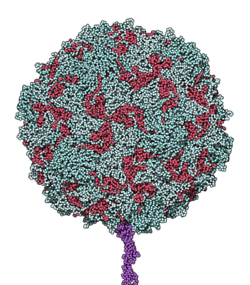| PVR |
|---|
 |
|
| Structures disponibles |
|---|
| PDB | Recherche UniProt humaine: PDBe RCSB |
|---|
| Identifiants PDB |
|---|
4FQP, 1DGI, 1NN8, 3EPC, 3EPD, 3EPF, 3J8F, 3J9F, 3UDW, 3URO |
|
|
| Identifiants |
|---|
| Aliases | PVR |
|---|
| IDs externes | OMIM: 173850 HomoloGene: 9672 GeneCards: PVR |
|---|
| Position du gène (Homme) |
|---|
 | | Chr. | Chromosome 19 humain[1] |
|---|
| | Locus | 19q13.31 | Début | 44,643,798 bp[1] |
|---|
| Fin | 44,666,162 bp[1] |
|---|
|
| Expression génétique |
|---|
| Bgee | | Humain | Souris (orthologue) |
|---|
| Fortement exprimé dans | - stromal cell of endometrium
- îlot de Langerhans
- ventricule gauche
- right lobe of liver
- upper lobe of left lung
- anté-hypophyse
- left adrenal gland
- nerf sural
- right adrenal gland
- aorte ascendante
|
| | | Plus de données d'expression de référence |
|
|---|
| BioGPS | |
|---|
|
| Gene Ontology |
|---|
| Fonction moléculaire | - protein homodimerization activity
- virus receptor activity
- liaison protéique
- signaling receptor binding
- cell adhesion molecule binding
- signaling receptor activity
| | Composant cellulaire | - cytoplasme
- integral component of membrane
- membrane
- focal adhesion
- membrane plasmique
- integral component of plasma membrane
- région extracellulaire
- surface cellulaire
- exosome
- milieu extracellulaire
| | Processus biologique | - heterophilic cell-cell adhesion via plasma membrane cell adhesion molecules
- cell recognition
- susceptibility to natural killer cell mediated cytotoxicity
- adhésion cellulaire
- positive regulation of natural killer cell mediated cytotoxicity directed against tumor cell target
- regulation of immune response
- pénétration virale
- susceptibility to T cell mediated cytotoxicity
- viral process
- adherens junction organization
- positive regulation of natural killer cell mediated cytotoxicity
- homophilic cell adhesion via plasma membrane adhesion molecules
| | Sources:Amigo / QuickGO |
|
| Orthologues |
|---|
| Espèces | Homme | Souris |
|---|
| Entrez | | |
|---|
| Ensembl | | |
|---|
| UniProt | | |
|---|
| RefSeq (mRNA) | |
|---|
NM_001135768
NM_001135769
NM_001135770
NM_006505 |
| |
|---|
| RefSeq (protéine) | |
|---|
NP_001129240
NP_001129241
NP_001129242
NP_006496 |
| |
|---|
| Localisation (UCSC) | Chr 19: 44.64 – 44.67 Mb | n/a |
|---|
| Publication PubMed | [2] | n/a |
|---|
|
| Wikidata |
|
Le CD155 (ou PVR pour « polio virus receptor », ou NECL5) est une protéine de type cluster de différenciation dont le gène, PVR, est situé sur le chromosome 19 humain. Il agit comme un récepteur à la surface de certains lymphocytes.
Rôles
Ses ligands sont le CD226[3]. Il permet la stimulation des lymphocytes NK, avec production de cytokines dans certains cancers[3]. Son action sur le CD155 est cependant contrecarré par le CD96[4].
Un autre ligand est la protéine TIGIT, qui interagit avec le CD155 pour, cette fois-ci, inhiber l'activité des cellules NK[5].
Notes et références
- ↑ a b et c GRCh38: Ensembl release 89: ENSG00000073008 - Ensembl, May 2017
- ↑ « Publications PubMed pour l'Homme », sur National Center for Biotechnology Information, U.S. National Library of Medicine
- ↑ a et b Chan CJ, Andrews DM, McLaughlin NM et al. DNAM-1/CD155 interactions promote cytokine and NK cell-mediated suppression of poorly immunogenic melanoma metastases, J Immunol, 2010;184:902–911
- ↑ Chan CJ, Martinet L, Gilfillan S et al. The receptors CD96 and CD226 oppose each other in the regulation of natural killer cell functions, Nat Immunol, 2014;15:431–438
- ↑ Stanietsky N, Rovis TL, Glasner A et al. Mouse TIGIT inhibits NK-cell cytotoxicity upon interaction with PVR, Eur J Immunol, 2013;43:2138–2150
 Portail de la biologie cellulaire et moléculaire
Portail de la biologie cellulaire et moléculaire  Portail de la médecine
Portail de la médecine

 Portail de la biologie cellulaire et moléculaire
Portail de la biologie cellulaire et moléculaire  Portail de la médecine
Portail de la médecine 














